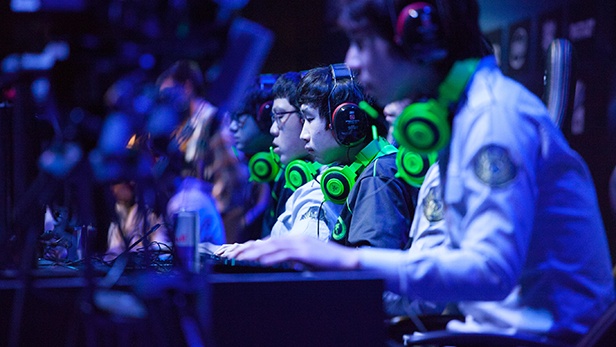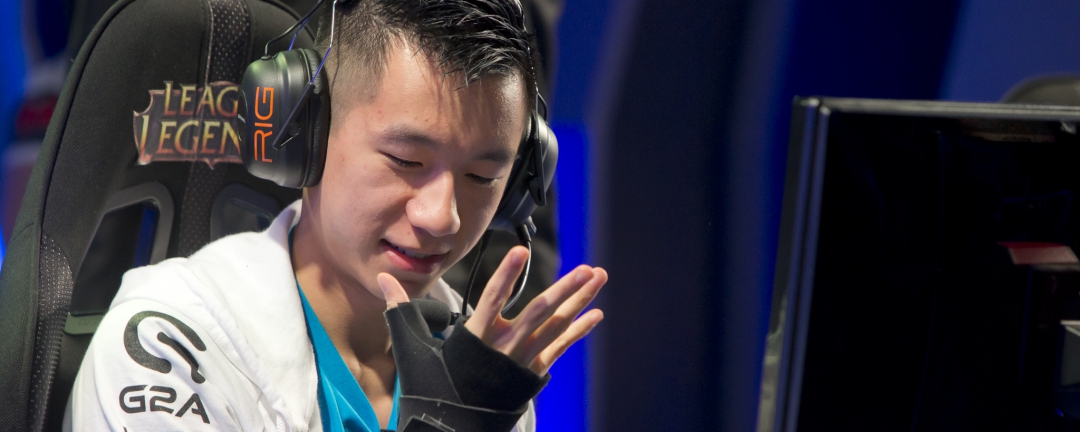
Photo courtesy of trustedreviews.com
The state of esports
By Benson Lu
Esports is a growing industry that may soon reach the level of traditional sports with the amount of fan support, revenue and funding by the investors it has been gaining. Professional gamers go through a strict daily schedule to hope and achieve their goals. Esports have been around since 1947, and it has grown a large amount from when it first started. The first major computer gaming game introduced was Starcraft: Brood War by the company Blizzard in 1998. Starcraft offered limitless potential and become one of the major drives of the eSports world, although it would not reach the height of its popularity until after the year 2000.
In the year 2000, major international tournaments such as the World Cyber Games and the Electronic Sports World Cup were held. In 2002, Major League Gaming, also known as MLG, was launched and became one of the largest and most successful eSports leagues, featuring multiple games while offering huge prize pools.
In 2010, Blizzard transitioned from Starcraft: Brood War to Starcraft II: Wings of Liberty. As the game moved on, so did the players. The Global Starcraft II League, also know as the GSL, was a South Korean league, widely known for its prestigious Starcraft II competitions and was arguably the pinnacle of the gaming world.
Eventually, new games came out over the years such as Dota 2, League of Legends, Counter Strike: Global Offensive (CSGO), Overwatch, and many more, which caused the once biggest game to die out. All of the investors and big companies moved on, and the Starcraft II scene was practically dead only a few months ago.
With many teams competing against each other, the best in the league fight it out to see who has the right to claim first place. With competition carrying stakes this high, they are normally held at big arenas. Arenas such as Staples Center in Los Angeles, Royal Opera House in London, Key Arena in Seattle, Sangam World Cup Stadium in Seoul and many more have been sold out to watch these games live. With stages these big, the prize pool of these tournaments are huge. Dota 2 hosts a yearly tournament called The International, T.I. for short.
In 2016, its whole prize pool was over $20 million dollars. With a prize pool this big, every team strives to play their best and win. The International’s prize pool also happens to be the biggest ever, beating the Super Bowl and the World Cup, containing only $37 million dollars in the prize pool that year. In an article by Henry Young, “According to Newzoo, the eSports global audience grew from 204 million to 292 million between 2014 and 2016, and it is projected to exceed 427 million globally by 2019. Global revenue in the industry rose from $194 million to $493 million in the same period, and is expected to reach 1 billion by 2019.”

With so much money at stake, there have also been match-fixing and scandals in recent years. The latest scandal happened in South Korea, where a famous player in the Starcraft II scene named Lee “Life” Seung Hyun, was caught match-fixing two games for $62,000 each game. Many people were let down after hearing this, because Life was a favorite to win the World Championship that year, and is arguably one of the best Starcraft II players in the world. Life lost a major opportunity due to this, and it was an action very questionable considering he was only 19 years old.
As video games continue to grow, so does eSports, and as games become more advanced, they become more exciting for spectators. Esports has yet to achieve popularity in the mainstream culture, but the phenomenon is approaching a tipping point where it will. The widely used website Twitch.tv is a live streaming platform for streamers. Nearly every big eSports tournament is streamed for free on Twitch. Twitch allows people to watch their favorite team or individual player live while chatting with spectators. Some people watch purely for entertainment, others watch to learn from the best and hopefully apply knowledge to their own games.

The 2013 League of Legends world championship attracted 32 million online viewers, more than double baseball’s World Series and even beating game seven of basketball’s NBA finals. While having 32 million online viewers, the Staples Center also sold out all their seats for people to watch the finals live. The 2014 League of Legends world championship attracted 40,000 fans to Sangam Stadium in Seoul which hosted a FIFA World Cup semi-final match in 2002. Quoted in an article by Henry Young, “In 10 years time, it will be as big as the NHL,” leading gamer Olof “olofmeister” Kajbjer tells CNN. Without spectator-friendly games, eSports tournaments would be nothing like it is today.
A professional gamer might not seem to be an athlete to some people, but in actuality they do a daily routine that many cannot do, just to improve. The typical stereotype that all gamers live in their parent’s basement is false, at least for eSports teams. Organizations are investing more and more into team houses, where the entire team can live and play under one roof. The main goal of these team houses is to increase team chemistry by turning teammates into real life friends, because out of game relationships within the team directly affect how they play in big moments.
Gamers spend large amounts of time developing new skills that will help them compete in their games. Players are constantly going through different scenarios that may come up in a game and calculating their reactions. Sam Mathews, the founder of Fnatic, tells CNN that he defines eSports as “competition augmented by technology.” Esports are highly strategic and can be up to 10, 12 hours a day of gaming just to perform a single movement or skill shot better. Many teams have a live-in coach, analysts, and an entire support network just to help the players improve everyday. With so many hours in front of a computer screen, the players take short breaks off the computer and do activities to shorten the amount of stress they’re taking in. An example would be going to the gym and working out for a while.
Strategy games such as Counter Strike and League of Legends are extremely complex. In addition to motor skills, the games require a high degree of understanding for an athlete to defeat their opponent. In the article by Martin Schütz, Professor Ingo Froböse says, “The amount of stress hormone cortisol produced is about the same level as that of a race car driver. This is combined with a high pulse, sometimes as high as 160 to 180 beats per minute, which is equivalent to what is happening during a very fast run, also a marathon.”
Esports athletes are exposed to physical strains similar to those of “normal” athletes. Professor Ingo Froböse began studying eSports in 2011, making him sort of a pioneer. “We are particularly impressed by both the demands place on the motor skills and their capabilities,” Froböse said. “The eSports athletes achieve up to 400 movements on the keyboard and mouse per minute, four times as much as the average person. The whole thing is asymmetrical because both hands are being moved at the same time and various parts of the brain are also being used at the same time,” he added. One of the most common strains on players is the wrist injury, which greatly affects a player’s performance.

Similar to all the people who agree eSports is becoming a sport, there are many that don’t believe so. Tim Warwood is a former UK snowboarding champion who now commentates for the BBC. He agrees that computer gaming is not a sport. In an article by Ben Dirs, Warwood says, “Sitting down for hours in a darkened room playing computer games doesn’t strike me as sport. To have kids sitting there looking at computer screens indoors, alongside snowboarding and freestyle skiing and all the rest, it just doesn’t seem right.” However, Warwood remembers a time not too long ago when snowboarding wasn’t considered a real sport either and snowboarders were “outcasts and outsiders”. “When I started snowboarding,” he says, “my gran thought I was a professional snowballer, as in, I was throwing snowballs for a living.”
A former judoka named Michal Blicharz, originally from Poland, has fulfilled many roles in eSports, from competitor to referee to coach. In Ben Dirs’s article, Blicharz explains, “Judo and eSports are not that dissimilar. There are tournaments, you have to climb up a ladder to eventually compete with the best. In terms of training you have to put in the same amount of hours, perhaps even more in esports. You study strategy, technique, and opponents. All the elements are there – the excitement, the adrenalin, players crying tears of sorrow and joy.” Blicharz does admit that physical exertion in eSports is minimal, although some players do suffer from strains and injuries. As Blicharz says, “Why should a horse be forced to prove it is indeed a horse?”
There are people who already acknowledge how eSports is considered a sport, those who may soon acknowledge it, and those who completely do not acknowledge it. As an industry, eSports will continue to grow with all of the resources it has been gaining. The tournaments, competitions, organizations, investors, players, and fans will not be going anywhere anytime soon, besides upward.
Works Cited
Dirs, Ben. “Is Computer Gaming Really a Sport?” www.bbc.co.uk BBC. N.P. Web. 11 April 2017
Li, Roland. Good Luck Have Fun: The Rise of Esports. New York: Skyhorse Publishing, 2016. Book.
Schütz, Martin. “Science Shows That eSports Professionals Are Real Athletes.” DW.com Deutsche Welle. 3 December 2016. Web. 11 April 2017.
Semler, Jordan. “Are eSports Real Sports?” factmyth.com FactMyth. 8 July 2016. Web. 11 April 2017
Totanes, Bryant. “Are eSports Considered Real Sports?” highschool.latimes.com Los Angeles Times. 13 December 2016. Web. 11 April 2017.
Young, Henry. “ Seven-Figure Salaries, Sold Out Stadiums: Is Pro Video Gaming a Sport?” edition.cnn.com CNN International Edition. 31 May 2016. Web. 11 April 2017.